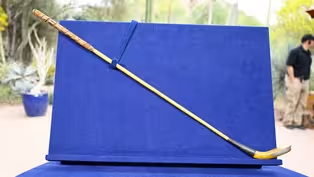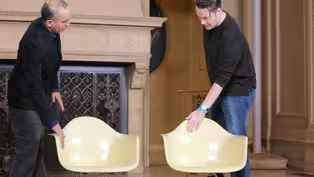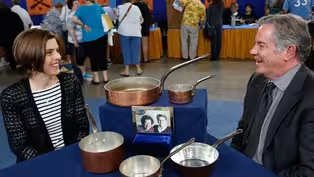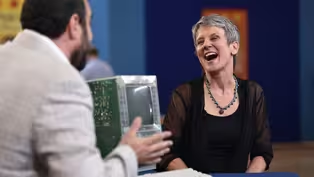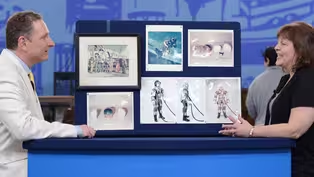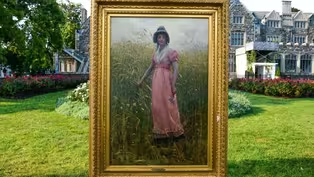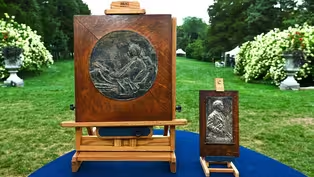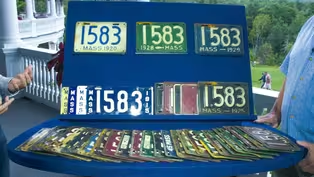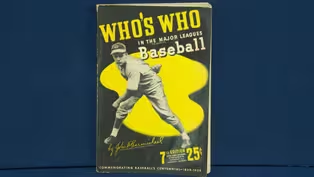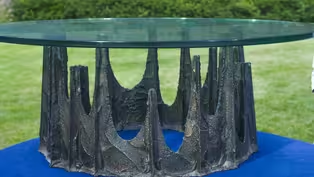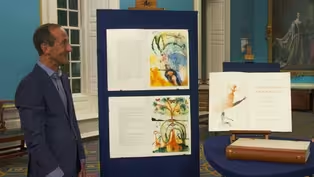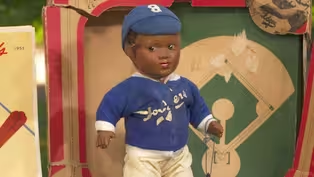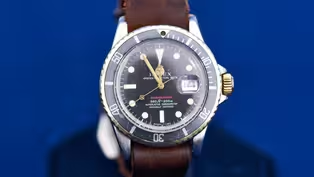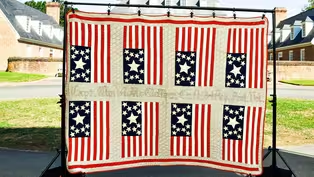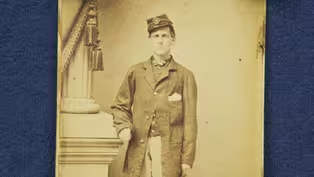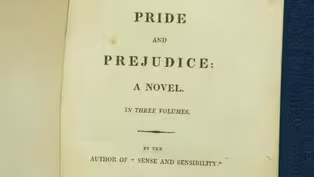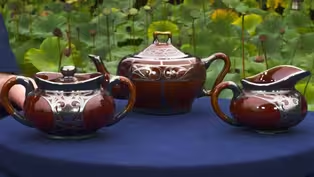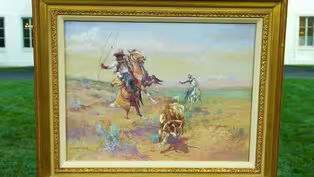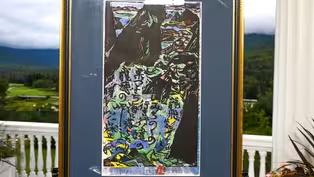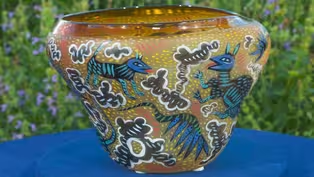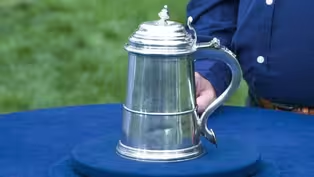
Junk in the Trunk 11
Season 26 Episode 25 | 52m 27sVideo has Closed Captions
Discover all new appraisals from ROADSHOW’s Season 26 tour, like a find of up to $75,000!
Discover all new appraisals from Season 26 of ROADSHOW, including an 1813 Jane Austen Pride and Prejudice 2nd edition, 1939-1940 baseball signatures and book, and a Jehan Georges Vibert oil. Guess the big find from the Junk in our Trunk!
Problems playing video? | Closed Captioning Feedback
Problems playing video? | Closed Captioning Feedback
Funding for ANTIQUES ROADSHOW is provided by Ancestry and American Cruise Lines. Additional funding is provided by public television viewers.

Junk in the Trunk 11
Season 26 Episode 25 | 52m 27sVideo has Closed Captions
Discover all new appraisals from Season 26 of ROADSHOW, including an 1813 Jane Austen Pride and Prejudice 2nd edition, 1939-1940 baseball signatures and book, and a Jehan Georges Vibert oil. Guess the big find from the Junk in our Trunk!
Problems playing video? | Closed Captioning Feedback
How to Watch Antiques Roadshow
Antiques Roadshow is available to stream on pbs.org and the free PBS App, available on iPhone, Apple TV, Android TV, Android smartphones, Amazon Fire TV, Amazon Fire Tablet, Roku, Samsung Smart TV, and Vizio.
Buy Now
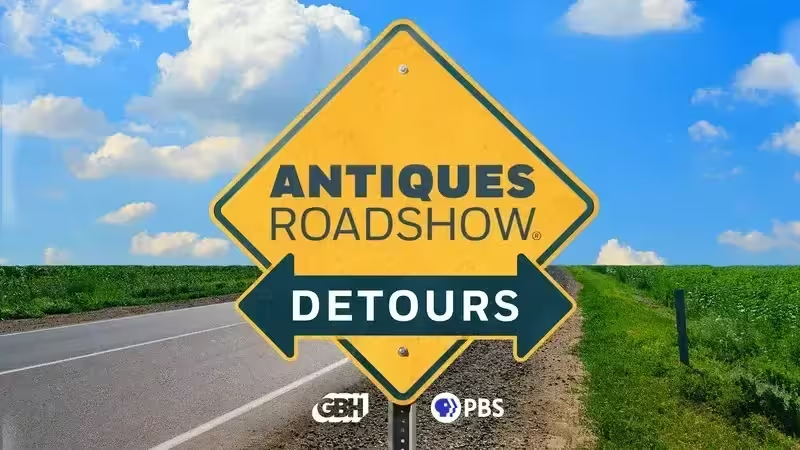
ANTIQUES ROADSHOW DETOURS
Ever wondered what happens to the treasures featured on America’s beloved ANTIQUES ROADSHOW after the cameras leave town? Host Adam Monahan tracks down the juicy afterlives of your favorite finds from PBS’s hit series.Providing Support for PBS.org
Learn Moreabout PBS online sponsorshipMore from This Collection
Video has Closed Captions
Discover never-before-seen surprises from our Season 24 tour. One is worth up to $100K! (52m 45s)
Video has Closed Captions
Discover never-before-seen appraisals from all Season 23 cities, like a $40K-$60K find! (52m 29s)
Video has Closed Captions
ROADSHOW’s bigger-than-ever 2014 season includes a second hour of junk! (53m 10s)
Video has Closed Captions
Discover more previously unseen appraisals from our eight-city tour. (53m 10s)
Video has Closed Captions
See never-before-aired appraisals from this season’s eight-city tour. (53m 6s)
Providing Support for PBS.org
Learn Moreabout PBS online sponsorship♪ ♪ CORAL PEÑA: "Antiques Roadshow" was thrilled to be back on the road for our 26th season.
It's in your face.
APPRAISER: It's exuberant and creepy at the same time.
(both laughing) PEÑA: We're stopping in every tour city right now in this episode of extra treasures, "Antiques Roadshow: Junk in the Trunk."
♪ ♪ PEÑA: Season 26 was an unusual tour.
We were still operating during a pandemic, so taking extra precautions meant having a closed set with a smaller crowd.
But that didn't mean there was any less excitement for what "Roadshow" does best: discovering treasures and sharing them with you.
Starting at Wadsworth Mansion in Middletown, Connecticut, our crew, experts, and guests got right back into the groove.
By this maker?
WOMAN: Yes.
Right.
WOMAN: It was given to my fifth great-grandfather in 1745, Captain Thomas Perkins, for something that he did at the Battle of Louisbourg at, in Cape Breton.
And what about the maker?
Do you know anything about who made it?
We were told it was made by-- and I can't remember his name-- but the, the teacher of Paul Revere.
That's in the family history, but I don't know whether that's true or not.
Okay.
The maker actually has nothing to do with Paul Revere, but it does have something to do with another important American Federalist.
This was made by a silversmith in Boston, a very important silversmith, by the name of William Holmes.
William Holmes was the nephew of Benjamin Franklin, and he was born...
Seriously?
Mm-hmm-- he was born in Benjamin Franklin's father's house, who was his grandfather, when Benjamin Franklin was only ten years old.
Is there anything special about the tankard that you know of?
It's called a whistling tankard.
I understand a whistling tankard is where, uh, they'd sit in the pub, and they'd...
When it was empty, they'd whistle, and the guy would come and fill it up.
The whistling part of the tankard is right here.
Uh-huh.
There's a hole for the air to come out, but somewhere there should be a hole for the air to go in.
But during a repair at some point... Oh... ...that has been lost.
Whistling tankards are quite rare.
Really?
And especially in American silver.
(chuckles) I think for an insurance valuation, I would put it somewhere between $15,000 and $25,000.
(laughing): Seriously?
Bless his little heart.
Really neat.
That is great information.
(laughs) Thank you so much.
Well, it's-- sure.
WOMAN: I've been collecting charms for a very long time, and this bracelet is a food charm bracelet, because I'm always on a diet, I'm always hungry.
(laughing): I didn't feel deprived without food...
I love that.
...when I was doing that.
I love that.
Looking at some of these charms, they actually move.
I think these were made about 30 to 50 years ago.
Charm bracelets are back in vogue right now.
And I would say, for insurance purposes, you'd be looking at about $6,000.
No!
Yup!
Oh, my goodness.
I don't feel deprived at all.
(laughing): No, you shouldn't, you shouldn't.
It w, hung in the dining room of my mother's home ever since I was a child, so, um, many years.
And then when she passed away in 1995, it was simply packed away in a box and it's been in a cellar ever since.
What you have here is a charger by William Hunt Diederich.
We know that this is done somewhere between 1918, 1940.
There's so much energy, and emotion, and movement.
There is, there's a lot of movement in the piece.
If I were to put this at auction today, I would probably put a pre-auction estimate of $3,000 to $4,000.
Lovely!
Thank you so much.
The gentleman nearest you is my great-great-grandfather, and he was friends with Augustus Saint-Gaudens.
And the story I always heard was that Saint-Gaudens was working on his Lincoln statue for Chicago's park, and my great-great-grandfather, Charles Cotesworth Beaman, said, "Why don't you come up to Cornish, New Hampshire, "where I live?
There's lots of Lincoln-like men."
And so Saint-Gaudens came up there, and he rented a house from my great-great-grandfather, and he bought the house from my great-great-grandfather, supposedly in trade for doing a portrait of him and his wife.
Augustus Saint-Gaudens, certainly a, a king of American sculpture in the 19th century.
I think his best-known is his memorial to Robert Gould Shaw and the 54th Regiment, um, in Boston.
It was the first public, uh, sculpture commemorating African American soldiers.
A true sort of immigrant success story.
His family came from Ireland.
At a young age, he, uh, worked as a cameo carver.
He showed promise, he was sent off by his family to study in Paris, split his time between countries, but settled in, in Cornish.
So we've got your great-great-grandfather here, and then the subject here is Robert Louis Stevenson.
Is there any connection there or... Not to the family, that I know of, except that my dad always loved "Treasure Island," so... (laughs): So he really... Who doesn't?
He really cherished this piece.
Yeah.
Um, but other than that, I think it probably just was given to Beaman at some point by Saint-Gaudens and then came down through the family.
Saint-Gaudens traveled in artistic circles.
Like, he was a friend of Robert Louis Stevenson, offered to do this portrait, which is very well-executed.
He's sort of reclining, reading, he's got a book or paper sort of resting on his knee there.
Fine casting detail and subtleties.
It's three-dimensional, but it's very subtle.
So, both in bronze, they have their original oak frames, certainly look of the period.
The Beaman portrait is dated 1894.
The Robert Louis Stevenson is dated 1887.
And this has come up at auction with some frequency.
I would say at auction, uh, between $8,000 and $12,000.
The Beaman, this, again, I, I love the scale and the way it's presented.
And even though not as widely as appealing subject matter, I think the value is going to be a little closer because of condition-- a better surface to it, um, smaller.
But I still think you're looking in the $6,000 to $8,000 range.
Okay.
Um, so they're both just wonderful examples of an artist who's pretty much beyond compare in that time period, and it's just a treat to see.
Oh, okay, thank you so much.
It was my father's.
It was in our home as I was growing up.
My dad had gotten it in, I would say, during the '60s from a friend.
My dad was in the leather tanning business.
The artist is a fairly well-known Western painter named Olaf Carl Seltzer.
He was born in 1877.
He was actually Danish-born.
Mm-hmm.
But came to the States at a very young age.
His father had died, and he and his mother traveled to New York, and took the Transcontinental Railroad straight to Montana.
Hm.
Which is where he lived out most of his career.
Okay.
He was mostly a self-trained painter.
This is a gouache and watercolor on a paperboard.
It was a common medium for a lot of artists who got their start in illustration work.
Seltzer, early in his career, was illustrating for some publications in New York.
He worked in this medium throughout his career.
This particular painting has a lot of things going for it as far as Seltzer's work is concerned.
First of all, it's large.
It's very well done.
It's a completely finished work.
Many of his works were not as finished as this example is.
And, thirdly, it's very dynamic.
Mm-hmm, right.
A lot of his subjects were static.
The last thing I would note is that the figure in the foreground appears to be a Native American, which was his favored subject.
Although I have not seen him depicting Native Americans in this context before.
It's just an unusual subject for him, and compelling, I think.
It's also signed here in the lower left, and dated clearly 1911, which would be earlier in his career, but right when he was hitting his stride during his most mature period of work.
An example in this size, for a fair market value and auction value, I would place a conservative estimate of $15,000 to $25,000 on it.
Okay, great.
That's great, thank you.
PEÑA: In Bretton Woods, "Roadshow" was in New Hampshire for the first time, at the Omni Mount Washington Resort.
The breathtaking beauty of the White Mountains was the perfect backdrop to look at treasures our guests and experts thought were beautiful in their own right.
WOMAN: I got this from my mom.
She always told me that this was a one-of-a-kind piece.
I never really believed her until I found the little thing that came along with it.
And, sure enough, it is one of a kind.
I know that it was made in Sweden by Kosta Boda, but other than that, I know nothing about it.
The piece was made by Kosta Boda... Uh-huh.
...probably in the early '80s, and it was decorated and designed by Ulrica Hydman-Vallien.
Kosta Boda would have blown the glass and then she would have painted directly on it.
Oh, I see.
Ulrica was one of the very important Swedish women artists, uh, who were working in the 1970s and the 1980s, and actually, until her recent death.
This is really wild, this particular piece... (laughing): Yes.
...because I was looking at it and there, there are all these lovely animals.
You see things that look like rats, dogs, wolves.
It's certainly a unique piece just based on the decoration and also the asymmetry of the piece.
Mm.
And of course, on the underside, we even have the signature where it says that it's unique.
Mm-hmm.
Right.
I like its exuberance.
It's, like, kind of exuberant and creepy at the same time.
(laughing): Yes, true.
From a decorative standpoint, and the fact that she's considered to be very important... Mm-hmm.
...I would say in the neighborhood of maybe $1,500 to $2,500.
Oh, my, that's amazing.
In a retail shop.
(chuckling): Oh, okay.
Oh, my goodness.
Well, jeez, thanks so much.
MAN: A collection of license plates that goes back to my grandfather.
And, uh, he, for whatever reason, and the family following him have kept every license plate, uh, with the number 1583 since 1915.
And do you still carry this plate today?
I still have it on the back of my car.
Massachusetts was the first state, beginning in 1903, to actually have state-issued license plates.
Yeah.
So, New York technically pre-dates it, 1901.
But in 1901 for New York, the owners of the vehicles themselves had to actually create their own license plate.
(chuckling): License plate!
In the world of license plates, you really can't get much better than the collection you have here today, because having consecutive license plates of the same issue... Mm-hmm.
...is unbelievable.
1915, the first four-digit, 1583.
And this is a porcelain over enamel license plate, which was faded out as we get into 1920, which is right here.
A-ha.
This is a tin embossed license plate.
Now, when you go through the collection, you have every single year except when we get to 1943, 1944.
That's right in the heat of World War II.
In order for the metal shortage, Massachusetts was only minting new plates for new registrations.
Interesting.
And now we continue down the years, as you hit 1949, but your next plate jumps to 1951.
Yup.
That's because someone had the bright idea, why do we need to mint license plates every year for someone to put on their car?
(laughs) So they alternate every other year of printing for the plates, and then by the time you get up through 1967, that's your last year, because after that, Massachusetts wasn't punching the date into the plate.
They went to the sticker registration.
In the world of auction today, conservatively for the group, we'd see this bring in the $2,000 to $3,000 range.
Wow.
In terms of registering a vehicle today, it is so hard to get a low-digit plate.
It's so awesome to hear that you still have it.
Yeah, we enjoy it.
My granddaughter's in line for the next... That's awesome!
...set of plates.
MAN: My father went to Notre Dame in the late '30s, early '40s.
And he played football at Notre Dame, um... Well, he's number 69 here, so I'm assuming defensive or offensive lineman?
Absolutely, he was defense.
Knute Rockne, probably the most famous coach of Notre Dame, is the one who is responsible for the design of this jacket.
Wow.
And your father played two great dynasties post-Rockne.
It's a great sideline jacket.
And there are only a few that have surfaced.
Huh.
Value-wise, I would probably put an auction estimate of, say, $4,000 to $6,000.
Whoa, okay.
I'd insure it for at least $10,000.
Wow, okay.
(laughs) MAN: This is a Paul Evans coffee table that I inherited from my grandparents a couple of years ago.
As far as I know, it's made of cast bronze.
My grandfather was a dentist.
They had six kids.
So they put an addition on their house in, like, the late '60s, early '70s, and hired an interior designer to decorate the whole place.
And this was part of that designer's choices.
Growing up with it, it always stuck out as sort of a unique piece of the room.
Their old cat used to always, like, creep through there, and at Christmastime, my grandma would put a, a Christmas manger inside, in the middle.
A lot of fond memories of my childhood around this table.
This was a pretty avant-garde thing to buy and furnish your home with in the early '70s.
In fact, we know that this table was made in 1970 because it's signed "P.E.," for Paul Evans, "'70."
Mm-hmm.
It's not a bronze table.
Okay.
But it has a bronze color to it.
What Paul Evans did was, you get a steel base, you put resin on top, and then you shoot it with a bronze dust, uh... And did that give every piece sort of a unique finish?
Exactly-- exactly.
Huh.
So not something like bronze, which is just cast, and the same thing is turned out over and over and over again.
Yeah.
So each one is a little different.
Paul Evans worked out of New Hope, Pennsylvania.
Okay.
And he was part of a studio movement in the '60s and '70s.
They didn't just build furniture, they considered themselves artists.
Mm-hmm.
Hence they were signing their pieces and dating their pieces.
He had great acclaim through the '70s, and then by the 1980s, he falls out of favor style-wise, and then recently, they've become very, very popular.
This is a piece of Brutalist furniture, and it's the kind of thing that, it's in your face.
It's very aggressive, um... Yeah, definitely a statement piece for the room.
Yes.
And it's, like, you love it or you hate it.
For me, this furniture, it grows on you.
So, any idea of its value at all?
I did see some search results for some auctions where it was selling for $5,000 to $8,000 range.
Mm-hmm, mm-hmm.
I was going to say $5,000 to $7,000...
Okay.
...because I'm an auctioneer and I'm conservative.
Great.
That is bingo, right where this table would be.
WOMAN: My parents bought it at a show at the May Company in Cleveland.
And the May Company is a big department store, and they were having a showing of the artist's work.
They bought this picture for $139.
I believe my parents met him because we have a signature on the back of one of the programs.
This is a fantastic example of the work of Shiko Munakata, who is one of the most important Japanese artists of the 20th century.
He's a modern master of printmaking.
And this is a very good example of his work from the mid-1960s.
1967 was when the show was at the May Company.
Mm-hmm.
Right.
It was actually his third trip to the United States.
Oh.
And it went on, this show, to the Smithsonian and the Brooklyn Museum.
So he really already reached, uh, quite a level of notoriety in the United States.
At the time, you wouldn't acquire the actual print.
They would have an example, and then the artist would then later produce the one that the customer ordered.
I know that my father had put a notation on the bottom of the, uh, program that it would arrive in six weeks.
Yes, so...
So he didn't take it home that day.
The work might be slightly different from the work that they saw.
Part of that is his technique, because they're multiples, they are woodcut prints, printed from a wood block.
Mm-hmm, mm-hmm.
But each one has its unique qualities.
There's a lot of variation in his prints, and then the coloring can, can vary.
And he printed them not like a modern edition, where they're each numbered.
He would just produce one at a time per order.
The black ink is printed from the carving, and then they're colored from behind with watercolor, and it bleeds through the thin Japanese paper.
This print is "Ode to Shinkai."
And "shinkai" in Japanese means an uncultivated open space, or something uncharted, or a deep sea.
So it, it really sums up this print.
It's a wonderful image.
It shows his incorporation of landscape and Japanese text.
The colors are really fresh.
It's been well looked after.
Do you have a sense of the value of this print?
Well, when I inherited it, it was appraised at $5,000 for the estate tax.
And then later, we had somebody else look at it who said it could be worth up to $15,000.
$15,000 would be more of a retail price.
I'm more comfortable with an auction value, because that's what I see more of.
I would value a print like this at auction between $6,000 and $9,000.
Okay, so kind of right in the middle of the two appraisals I got.
Munakata prints reached their peak in the '90s as far as collectibility.
But fine examples like this, with color, with a lot of expressive qualities, are very collectible.
Okay, great.
♪ ♪ PEÑA: At Sands Point Preserve, we got to imagine what life might have been like living in the lap of luxury on the Gold Coast of Long Island in the Roaring '20s.
Hempstead House, once the home of Daniel and Florence Guggenheim, was a grand setting for appraisals full of surprises.
MAN: I got an old baseball book, uh, found in the bottom of a box lot, and had signatures in it from 1939-1940 baseball.
This is something you purchased at an auction.
Correct-- I was hopeful that not too many other people had seen it at the bottom of a box lot, and so I was just waiting for it to come up.
No one seemed to be interested in the box lot, so I got it for ten dollars.
Oh, I can't imagine that excitement you must have had waiting for that to come up.
Oh, yeah, yes.
And how long ago was that?
It was about five years ago now.
It's the 1939 "Who's Who in the Major Leagues."
This magazine, "Who's Who in Major Leagues: Baseball," was a competitor to "Who's Who in Baseball."
It is a 1939 seventh printing, and when you look at it, it is a pretty simple booklet.
So it's basically a media guide that was sold to the public.
We see it says 25 cents on the cover right there.
They're real thorough guides, quick little bio, but have real thorough stats in the back.
We open up to the first page here.
So who do we have here on the first autographed page?
Lou Gehrig.
Lou Gehrig.
What'd you think when you saw that?
Um, my heart, uh, started to race.
Yeah.
So 1939 was Lou Gehrig's final season.
He was diagnosed with A.L.S., unfortunately passed in 1941 at age 37.
A 1939 signature of Lou Gehrig are very scarce.
And that's a beautiful signature, like all the others in this book, real crisp, has barely seen the light of day.
Beautiful Joe DiMaggio signature there.
He, of course, came up in 1936.
We'll skip another couple pages here to another important autograph.
We have a signature of a rookie Ted Williams.
Mm-hmm.
On a scale of one to ten, it's a ten.
But what really jumps out about this book is the amount of signatures.
In total, how many signatures are in this book?
About 184, I think.
I'm not aware of a baseball publication from this era that has as many signatures as this book.
Oh, nice.
You hit a home run.
(laughs) I would put a value of this at auction at $10,000 to $15,000.
Fantastic.
It will, it will go to the kids, 'cause they're baseball fans, also.
But, nice.
Had no idea.
♪ ♪ My great-grandfather was in the furniture business and used to travel to Europe, and went to Austria in 1914 and found this piece here.
And I remember as a boy growing up, uh, sitting here with my little sister on the other side.
While there are no labels on it, we feel very confident that it is by the firm of Thonet, which is an Austrian firm.
Michael Thonet patented and mastered the art of heat-treating and steaming wood to bend it.
If I were to see this come up for auction today, I would expect it to bring somewhere between $800 and $1,200.
Interesting.
It's a really lovely, fun example.
MAN: In 1967 to '68, I was traveling through Asia.
Bought it for $600, which is a lot of money.
Now, I'm going to say something that's going to be disappointing.
What is that?
Which is that it's not real.
Yes?
It's not real.
It is a fine-quality copy, made sometime likely between 1930 and when you acquired it.
Really?
I think it's difficult to know when.
So we would describe this as a Chinese Tang-style glazed pottery female musician.
In an auction sale, we're looking probably at somewhere between $200 and $400.
Hm.
I would say, if it were mine, I'd prize it just as much as anything that would be from the period or not.
Oh, absolutely, yes, but it's nice to know.
WOMAN: This is a second-edition set of "Pride and Prejudice" printed in 1813.
My dad bought it for me in London.
I must have been 12, um... That's a nice gift for a 12-year-old.
Yeah, I've always been a really voracious reader.
Yeah.
And he went into a bookshop and apparently the woman in the bookshop showed him this second-edition set, and he said, "Oh, that's really nice, "but I'd like to get her something special.
Do you have any first editions?"
To which the woman in the bookshop replied, "No, there's around 100 of them in the world, and they're all in museums."
And my dad said, "Oh, then I guess the second edition would be fine."
The author's name doesn't seem to appear on the title page.
Do you know about that?
It actually says "'Pride and Prejudice' in three volumes by the author of 'Sense and Sensibility.'"
When the books were published, it was not considered respectable for women to be writing, and certainly not publishing, and so frequently women, um, in the early 19th century did not have their names put into texts.
Right.
Well, you're absolutely right.
It's a second edition, 1813, London.
The first edition, it came out in January.
This came out a few months later.
Because of the popularity that, the kind of smash hit that the book created, the demand was there, and they reprinted it right away.
It's what we call a three-decker, meaning it's three-volume.
A first edition of this book is rare.
They're not all in museums, but the bookseller was at least being truthful.
Normally a second edition, I would say, of any book, just like your dad, you know, it's, it's not likely going to be valuable, and it certainly isn't going to be what the first edition is.
In this case, because the book was such an important book, and has such a key part in literature, that people like your dad have made that sacrifice of having to buy a second.
Do you have any idea what he paid for it, or any...
He told me that he remembers paying maybe a couple of hundred dollars.
And, now, what year?
Do you know when that was?
This would have been around 1995?
Second editions have come on the market, and the last copies have been bringing as high as in the $8,000 range.
Wow.
So I would put as an auction estimate on that $6,000 to $8,000 on it.
And your insurance value would be higher, be around $9,000.
It's probably one of the more valuable second editions you could find of any book.
So it's, it's worth noting that.
Good to have.
Not always a first.
You don't have to always be number one, you know?
(laughs) You can be...
I don't think I could have afforded to insure the first.
So it's okay.
(laughing): Yeah.
Thank you for bringing it in.
Thank you so much.
Well, the painting was done by Hamilton Hamilton.
I believe he was born in England, but came and lived in this country, and painted here for many, many years.
Did some portraiture, but also a lot of landscapes.
And I believe he was a member of the Silver Mines School.
Certainly all of that is true.
He was from Oxford, England, and as a young boy came with his family to an area right outside of Buffalo.
He did study briefly in Paris and then came back to the States in the early 1870s.
And by 1873, he was lucky enough to be able to go on an expedition out west, to Colorado.
And he did several paintings out there, which really brought him fame.
By 1876, several of those paintings were actually shown at the Centennial Exposition in Philadelphia.
Interesting.
And that was quite a coup for a young artist.
He settled in Connecticut.
So you're absolutely right.
He was part of the Silver Mine Art Guild, and this was a group of artists who were living in Norwalk, uh, Wilton, and New Canaan, Connecticut, and they sort of bonded together to have exhibitions and things of that sort, and they still exist today.
Hmm.
He was actually one of the founders when it was incorporated in 1924.
Now, the painting is signed and dated in the lower right.
And the date is 1882.
He established a studio in, uh, New York City in 1881.
So this would have been done around the time that he had a studio in New York.
It's oil on canvas.
There is a plaque on it with a title, which is "Coming Thru the Rye."
It may lay reference to Robert Burns's famous poem "Comin Thro' the Rye," which was written in 1782.
How did you acquire this painting?
This painting was actually from my maternal grandparents.
Shortly after I was married, my mother sugg-- who had had it in her attic for many years, since her parents' death-- said to me, "I think this would look well in your home."
And she offered it to my husband and myself, and we immediately said yes.
I got the painting in about the mid-'70s.
When it was found in the attic, what did it... Was it in this kind of condition?
No, unfortunately, it wasn't.
There was a bit of a slash through the center of the painting.
There was some mold on her face and some other places where the paint had kind of chipped away, as well as some issues with the frame.
So we took it to a local conservator at the time and they fixed it up for us.
Do you remember how much you paid for the restoration when you had it done?
I would imagine it was maybe in the $400 or $500 range.
The restoration was done beautifully.
The restoration really would not have any effect on the value.
This type of painting is called a genre painting, and this type of art in today's world is not quite as in vogue as it was, let's say, 25 years ago.
If this were in a gallery, it probably would sell in the range of around $15,000.
Ah, well!
If you were going to insure it, you would probably have put $20,000 on it...
Okay, that's good to know.
...for, for insurance purposes.
20 to 25 years ago, we were selling them more in the $40,000 range.
Wow.
Brown furniture and gold frames are not en vogue.
Yes.
♪ ♪ PEÑA: "Roadshow" was transported back in time when we set up our cameras in Virginia at Colonial Williamsburg.
With about 850 costumed staff, this living history museum really brings colonial America to the present.
What stories about the past are our guests sharing with the appraisers today?
Let's find out.
MAN: It was part of my mother-in-law's estate.
I looked at the illustrations and thought they were interesting and colorful, so I had them shipped home to my home.
I really didn't know what they were at the time.
I was very shocked when I found out that the illustrations were by Salvador Dalí.
Um... (chuckles) It's a portfolio with illustrations by Salvador Dalí, the preeminent Surrealist artist of the 20th century, illustrating the classic (chuckling): "Alice in Wonderland" by Lewis Carroll, which was first published in 1865.
And somebody at Random House, the publishing house in New York, had the brilliant idea to commission Dalí to illustrate Lewis Carroll's classic.
It's an amazing marriage, the two of them together, as you can see in these illustrations.
Dalí made 12 watercolors, one for each of the chapters in "Alice in Wonderland."
These are two of them.
You have the complete set in the box here.
And in addition to that, he made the frontispiece, which is an original etching.
Now, the imagery on that etching, which is a girl skipping rope, dates back to a painting he had done in the mid-1930s for an English collector.
He reused that here in this 1969 portfolio.
And in each of the images, you have the girl skipping rope, and that is Alice.
And down below is a seated figure representing the artist looking at his subject.
And all of the sets are pencil-signed on the title page.
It was an edition of 2,700, so there were quite a few of these made, and they sold out almost immediately, based on the popularity of, of not only Dalí at this point, in the late 1960s, but the Lewis Carroll novel, which, you have Carroll's text for each of the chapters.
This one here, up top, is "Down the Rabbit-Hole."
You have the rabbit, Alice there on top of the mushroom.
And here, this is the Mad Tea-Party.
I love this image because it has that bent clock, which so many know Dalí for.
Yes.
Condition, both externally-- the portfolio, the box holding the contents-- and internally, is, is flawless.
It's as good as I've ever seen a set like this.
There is a lot of value in the complete set in pristine condition, as you have yours.
And I would put a replacement value on your set at $15,000.
Wow.
It's beautiful.
Well, thank you, I'm... (chuckles) You're welcome.
That's a pleasant surprise.
(both chuckle) In 2007, I was working in the Virginia Army National Guard, and I had a sergeant major who presented me with an opportunity to buy, uh, several Rolexes.
They were all older.
He was into the estate hunting business, and I said, "Eh, sure, I'll take it."
What did you pay the sergeant major for the watches?
So, three watches, $5,000, uh, financed over about two years.
Okay, and do you wear the watches?
Rarely.
Rarely.
Rarely.
Okay, well, this watch is interesting, because it's what in the watch business we would call a Frankenstein.
(chuckles) So this is a Rolex model 1680, and this is the, uh, first Submariner that had a date on it.
It had an acrylic crystal, and the watch was made right in through the late '60s into the mid-70s.
The serial number of this watch dates it to about 1974.
Okay.
There were no gold and stainless versions of a Submariner during that time period.
Okay.
So, it was not uncommon for a customer to walk into a Rolex agent and say, "I have a two-tone Datejust," which did exist at the time, "and I'd like to make my Submariner a two-tone."
(chuckles) Yeah.
So the watch is fundamentally correct.
Okay.
The movement is right, the case is correct, but the hands are gold hands from a later date.
The bezel, which holds the insert, is a gold bezel from a later watch.
Okay.
And the crown is a gold crown from a later watch.
Okay.
In the beginning years of the Submariner, the word "Submariner" was in red.
That becomes a very highly collectible watch for sport watch collectors today.
The dial appears to be correct.
It's called a Mark IV dial.
The insert, which is what's inside the gold bezel, is called a Mark III.
Okay.
So, those two things correspond perfectly with the 1974 production date.
Okay.
So I'd have no doubt that this watch came out in '74 as a stainless steel Submariner.
But a long time ago, just based on the looks of it...
Yes.
...and the fact that you've already had it for 14 years, somebody did a conversion.
So, from a, a standpoint of value, um, today, at retail, as a Frankenstein, this would probably trade somewhere between $15,000 to $17,000.
Okay.
All right?
Thank you so much.
My father was Air Force.
He went to France to be stationed, and my mom, while they were there, bought this vase for $20 in a thrift shop.
So what years would that have been about?
Right around '57, '56.
The signature says "Le Verre Français."
Le Verre Français is actually made by a company named Schneider.
Your piece probably dates from around circa 1925, and it is cameo glass with a wonderful Art Deco design.
On the auction market, it would be in the $1,000 to $1,500 range.
Got ya, okay.
That's pretty good, pretty nice.
Very cool, thank you.
Yep.
WOMAN: I got this pillbox at Goodwill, and it was in a bag filled with other trinket boxes.
APPRAISER: How long ago was that?
Around about five months ago.
There was a little piece of paper in there that said it was a Russian enamel pillbox, and there were some marks on the inside.
I thought possibly that it might be a Fabergé.
Carl Fabergé was the jeweler to the last two tsars of Russia.
And I believe that your hunch is actually correct, that it is by Carl Fabergé.
You have this beautiful guilloché enameling.
It shows something that he was particularly known for, and that is taking an everyday type of object, a pillbox, and making it into a beautiful object.
The retail value would be $18,000.
Now, how much did you pay in the first place?
Um, it was in a bag, about seven dollars.
So that's a... A pretty good, uh, return... (laughs) ...on your money.
(laughs) Yeah.
This doll belonged to my mother.
I think she got it when she was a young teenager.
Growing up, it was in my grandparents' attic.
And every once in a while when we were visiting, we'd go up there, she'd take it out of the chest it was in.
We'd look at it, we'd put it back in the chest.
That's why it's still in the original box.
Then, when my mom died in 2000, I took possession of it.
I told my brothers and sisters, "I'll get it appraised," and 21 years later, I'm finally getting it appraised.
(both laugh) So you have your Jackie Robinson doll.
He's a composition doll.
And he came with his original box, which we rarely see.
He was the first African American player in Major League Baseball, and he really was a history-making person.
He really believed in civil rights, and he really went through a lot of hard times to be that first Black player.
He started in the league in 1947, this doll was made in 1950, and at that time, there were not a lot of Black dolls, especially Black portrait dolls.
This doll was made by the Allied Grand Toy Company, and he has on his original Dodgers uniform and he has his hat.
(chuckles) Hats and shoes are usually the first things to go on dolls.
And he even has his original hang tag, which is in very good condition.
With the set, you got the baseball bat and the two little brochures.
But how did you get this program?
I think that was from a game my mom went to back in 1955, and they just got Jackie Robinson's signature, I guess, at the game.
I did check with one of our colleagues that specializes in sports autographs, and he did indeed sign this.
He is in pretty good condition considering his original storage.
He does have a little crazing.
Mm-hmm.
On today's market, an auction value on your doll would be around $1,000 to $1,500.
Mm-hmm.
And then the program, it is worth $1,500.
Oh!
That's great.
So your total value is around $3,000.
That's awesome.
WOMAN: Captain William A. McClellan is my second great-grandfather.
He served in the Union Army in the Civil War.
He started out as a second lieutenant in Company D, the 84th Indiana Volunteers.
Throughout the course of the war, he elevated and ranked to, when he mustered out, he was a captain.
The quilt has come down through my family.
We believe that it was actually made for the period of time when he was attending the reunions of the Grand Army of the Republic.
I looked him up in the census and recognized that he was a farmer.
Mm-hmm.
And that struck me as interesting, because most officers, when they mustered in as a lieutenant or a captain, they had some above average education.
McClellan was 25...
Yes.
...I don't know if you knew that, when he mustered in...
Okay.
...which was relatively old.
Mm-hmm.
And that may be why he mustered in as a second lieutenant in a position of authority.
The 84th was a Western theater group.
Your feeling about the quilt, that it is a postwar quilt, I think is probably correct.
I think that you're right, that it probably has something to do with the G.A.R., or the Grand Army of the Republic...
Right.
Mm-hmm.
...which, of course, is the Union soldiers' veterans organization... Organization.
...that, that started out not long after the war ended.
Yes.
So it may have been made for his participation in G.A.R.
encampments and he took it with him.
I'll bet you that it was his wife who made this, and made it for him... Mm-hmm.
...to put on his camp cot.
The flags make this quilt.
Flags in, in themselves are, are often incorporated into quilts.
Mm-hmm.
But this particular example is really, really striking.
When you look closely at the name, it's stitched in red, and it's not close stitching.
No.
It's very loose stitching.
Have you ever thought about, "Gee, I wonder what this thing could be worth?"
Maybe $1,000.
In the right kind Of auction, with historical items... Mm-hmm.
...that related to the Civil War or American history, this quilt would probably sell for $10,000 to $15,000.
Now, that's just someone, potentially, who is an Indiana Civil War collector.
Civil War, yeah.
It might even sell for more in an auction of folk art and Americana to someone who is a quilt collector.
Collector.
I would probably feel pretty comfortable telling you an insurance value of this would be $20,000.
Wow.
When my mother gave it to me, it was, like, "Wow.
"Why did you keep this hidden all these years?"
(laughs) PEÑA: With nearly 300 contemporary works of art spread out across 42 landscaped acres, New Jersey's Grounds for Sculpture was the perfect blend of art and nature.
And made an unforgettable final tour stop.
WOMAN: I found these things in my great-grandfather's bureau when I were cleaning out the house.
There was a name on the back of the picture, Joseph Merrick.
Joseph was my great-great- grandmother's brother, so my great-great-great-uncle.
I found out that he was in the Civil War, and that he was, uh, was actually wounded in battle, and he, and he's buried at Arlington.
This pin was with it.
It has his name in the center, and it has all of the battles that his regiment, where they were at the time.
You have-- you called it a photograph.
It's actually, over here, called a CDV... Hmm.
...which stands for carte de visite.
And those were images done around the 1860s into the 1870s.
Soldiers loved to do those as mementos, send them to the family.
Mm-hmm.
Almost like a calling card, in a way.
Hm.
So on the back, it is identified in pencil.
It says "Joseph Merrick."
And it says "Rahway, New Jersey."
Yeah, that's where he's from.
Uh, and he was a member of the Company A, First New Jersey Volunteers.
It's a wonderful image of Joseph Merrick.
What's important is, A, it's identified, so we know who it is, the soldier it is.
Mm.
Uh, the jacket he's wearing was not a regular issue jacket.
It's a private purchase jacket, and you can tell by the larger pocket on the side.
And his cap has a corps badge, which also is terrific, because it also helps identify which regiment or which corps he was a member of.
Hm.
On this side of the pairing, we have a really, really nice Civil War pin.
I'm going to call it a mourning pin... Oh.
...because it was probably something given to someone in the family-- maybe a widow.
Mm-hmm.
Maybe a mom, maybe a family member.
Probably mom.
Basically, at the center, as you had said, it says "Joseph Merrick, Company A, First New Jersey Volunteers."
And around this beautiful-looking floral decoration, which is super-unusual-- I mean, I've honestly never seen one, and colleagues I spoke to about it have never seen that particular kind of formation... Mm-hmm.
...it lists all the battles he participated in, including Gettysburg, Bull Run.
They were in Manassas.
So, very important battles.
So he was in the Army of the Potomac.
At auction, a CDV like this, identified, with that great image of the coat and the corps badge, is probably in the $250 to $350 range.
Oh.
The pin itself I would estimate at auction between $3,000 and $4,000.
Oh, my gosh, wow.
So if you wanted to put them together, possibly at auction as a pair, $3,500 to $4,500 would be a fair estimate.
Wow, that's very surprising.
WOMAN: I went to an estate sale just shy of a year ago and spotted this.
And other people were looking at it.
And I said under my breath... (chuckling): "Get away from that, that's mine."
She's not a well-known artist.
Her name is Mariquita Gill.
She surfaces in Boston in the 1880s, where she's in art school.
In 1885, she followed the pathway of a lot of other American artists to Paris.
How much did you pay for it?
$7,000.
This is by far the best of the ones that I have been able to access so far.
Oh, that's cool.
And I think an auction estimate on your painting would probably be between $15,000 and $25,000.
Um...
Very nice.
And I think this would be a record-setting painting, and it may very well be the best painting she ever painted.
Oh, that's so great to hear.
WOMAN: The ring belonged to my mother, and I remember it as a little girl 'cause it's so big and shiny.
She wore it when they went out in the evenings all the time.
It's a cocktail ring, and a cocktail ring, by definition, is a large single stone to be worn out at a gay evening.
So this was exactly what this ring should have been.
This is probably one of the largest aquas that I've seen in a ring.
By formula, I'm coming at almost 50 carats.
Wow.
The color is beautiful, and the dating of it, I would say it's classic late '40s, '50s.
The value in the market today, at auction, is $12,000 to $18,000.
Wow.
Which is, for an aqua, quite a bit of money.
It is.
WOMAN: This was a tea set that I picked up with my father when I was six years old at an old barn in the Poconos.
And my father and mom used to take me antiquing when I was very young.
I know that it's Lenox from the stamp on the bottom.
I loved the coloring as a little girl; everything was always pink and flowery... Mm-hmm.
...and so I really liked it.
How much did you pay for it back then?
$25.
Lenox china was made in Trenton, New Jersey, maybe two miles from where we're standing.
Wow, mm-hmm.
Trenton was the art porcelain capital of America for perhaps 20 or 30 years.
Oh, I didn't know that.
The last ice age, as the glaciers pushed south, they pushed the terminal moraine south with them.
And in that terminal moraine, if you see that line across Jersey and Pennsylvania and Ohio, there are kaolin deposits and clay deposits... Mm-hmm.
...that were used in the manufacture of pottery and porcelain.
It's one of the reasons why that area in general is known for their ceramics.
Trenton clay deposits were very rich, and you had a dozen, two dozen companies making art porcelain in the 19th century?
Mm-hmm.
Walter Scott Lenox started the Ceramic Art Company in 1889 in Trenton.
Mm.
And it was an art company; they weren't making dinner sets, they were making decorative artware in the art pottery tradition.
And what's interesting about the mark on your pieces here... You have many marks on your pieces, which tell us quite a bit.
Number one, in the middle of the wreath is C.A.C., for Ceramic Art Company.
The wreath-- anybody familiar with the Lenox mark knows the, the wreath, because that's, uh, something they continued, with an L in the middle of it.
But this dates to about 1906.
You know that because of the cojoined mark of the Ceramic Art Company and Lenox, which is what Walter Scott Lenox turned the company into in about 1906.
Also, you've got a unicorn.
That's what fascinated me.
That's the Mauser mark; that's a silver maker.
They're quite rare.
Condition of your set is beautiful.
I would say a set like this is, at auction, between $500 and $1,000.
Okay.
It's staying with me, because it's the start for me of a love of all things antique.
MAN: Story goes that it was purchased by my great-grandmother and her husband in Paris back in the early 1900s.
It's a painting by Jehan Georges Vibert?
Right.
Who's a French painter, and it's called "The Sacrilegious Monkey."
Mm-hmm.
His paintings, I guess, were always kind of making a little bit of fun at the Catholic Church.
Exactly.
The painting is an original oil on what's called cradled panel.
There's a cradling on the back, which would assist in making sure that the painting remains flat.
Signed J. G. Vibert.
And these Cardinal paintings reflect a larger theme, if you will, that was going on in society at the time in Europe, where there was more of a, not so much necessarily a repudiation of the Church, but a different view of the Church.
The Church was not held in the same sort of high esteem.
Right.
There were political conflicts between the conservative Church and the more liberal state.
What I love about Vibert is the wonderful use of color.
He was somebody who was a real innovator.
He studied for six years at the École des Beaux-Arts and really mastered his craft, but an innovator in the sense that he was also a very accomplished watercolorist.
He is said to have been involved in the invention of certain kinds of brushes and varnishes.
And this particular color of red became known as the Vibert red, which he used to depict cardinals.
Really a great attention to high realism.
And the whole scene is really humorous.
Now, we know the title of the painting, or at least as it was presented from your great-grandmother.
Presumably that plaque was on it the same time she bought it.
And it says "The Sacrilegious Monkey" on the back of the painting.
Not all of Vibert's paintings are titled.
Not all of Vibert's paintings are dated.
I would probably date this work circa 1875, give or take, maybe a little bit later.
These kinds of humorous pictures were immensely popular.
Amongst the patrons, you had captains of industry such as John Jacob Astor, who were paying vast sums of money, along with William Vanderbilt.
A painting called "The Missionary's Story" sold for $25,000 during Vibert's lifetime, which was a fortune.
What I like about it is, it's fresh to the market.
You said it was acquired by your great-grandmother... Yeah.
In what, in the early 1900s?
Early 1900s, yeah.
So, Vibert died in 1902.
Given how important he was as an artist, how popular he was, and how much his paintings were commanding, one wonders, do we know how much she may have paid for it?
I have no idea.
One assumes it may have been a pretty penny.
Has the painting been appraised?
When my grandmother passed away, it was appraised at that time.
We paid $30,000 for it.
Right.
When, when we purchased it from her estate.
Right.
My feeling, or my concern, maybe, is that paintings of this genre, uh, in today's market maybe aren't so well-liked or, or sought after.
And maybe the price has gone down, but...
It doesn't really matter, because it's a family heirloom.
It's not going anywhere, so to speak.
Sure, sure.
But it's always curious to know.
Academic realists painting genre scenes have become a little bit out of favor relative to prices realized at auction, say, in the 1980s.
Mm-hmm.
Or in the 1990s.
The price that you paid, in my estimation, for auction purposes, is very close, in fact, almost spot-on, to what, in 2021, I would state as a value for the painting.
Okay.
I think at auction today, conservatively, I would price the painting at $25,000 to $40,000.
Okay.
I would probably want to insure the painting for about $75,000.
That's exactly where it is.
PEÑA: We hope you've enjoyed this special episode PEÑA: And now it's time for the "Roadshow" Feedback Booth.
Before today, this poor plate sat in the cellar in a box for over 20 years.
Uh, it will not be going back into the box in the cellar.
Instead, it will be hanging on the wall.
Today, I was surprised by the appraisal.
I was a happy camper.
And it shows that he actually went to an auction and got something that's worth something.
(chuckles) This is definitely going in the safe, I'm locking this up, and it's not going to sit on my bed stand anymore.
(chuckles) We brought today our father's Notre Dame sideline football jacket that basically hung in our basement all these years.
And today we found out it's worth a lot more than we thought.
And instead of riding in the trunk on the way home, it's coming in the front seat with me.
This is going to go back on my wall, uh, where I can ad, admire, uh, Great-Great-Granddad Beaman, uh, for many, many years.
We love the painting just as much today as we did 20 years ago.
It's staying with us.
It's a family heirloom from my great-grandparents, and we'll have it forever.
With the new information I learned today about this ring, I think it might be time to get insurance on it.
My, uh, son-in-law said this was worth about $20 and a bag of cheese sticks.
(chuckles) $1,000, big boy.
How about that?
PEÑA: Thanks for watching.
See you next time on "Antiques Roadshow."
Appraisal: 1882 Hamilton Hamilton "Coming Thru the Rye" Oil
Video has Closed Captions
Clip: S26 Ep25 | 3m 19s | Appraisal: 1882 Hamilton Hamilton "Coming Thru the Rye" Oil (3m 19s)
Appraisal: 1894 & 1887 Saint-Gaudens Bas-relief Sculptures
Video has Closed Captions
Clip: S26 Ep25 | 2m 44s | Appraisal: 1894 & 1887 Saint-Gaudens Bas-relief Sculptures (2m 44s)
Appraisal: 1915 - 1967 Massachusetts License Plates
Video has Closed Captions
Clip: S26 Ep25 | 2m 8s | Appraisal: 1915 - 1967 Massachusetts License Plates (2m 8s)
Appraisal: 1939 - 1940 Baseball Signatures & Book
Video has Closed Captions
Clip: S26 Ep25 | 2m 22s | Appraisal: 1939 - 1940 Baseball Signatures & Book (2m 22s)
Appraisal: 1970 Paul Evans Coffee Table
Video has Closed Captions
Clip: S26 Ep25 | 2m 29s | Appraisal: 1970 Paul Evans Coffee Table (2m 29s)
Appraisal: "Alice's Adventures in Wonderland" Illustration
Video has Closed Captions
Clip: S26 Ep25 | 2m 54s | Appraisal: 1926 Dalí-illustrated "Alice's Adventures in Wonderland" (2m 54s)
Appraisal: Allied Grand Jackie Robinson Doll & Program
Video has Closed Captions
Clip: S26 Ep25 | 2m 39s | Appraisal: Allied Grand Jackie Robinson Doll & Program, ca. 1950 (2m 39s)
Appraisal: Converted Rolex Red Submariner, ca. 1974
Video has Closed Captions
Clip: S26 Ep25 | 2m 46s | Appraisal: Converted Rolex Red Submariner, ca. 1974 (2m 46s)
Appraisal: Flag Quilt, ca. 1880
Video has Closed Captions
Clip: S26 Ep25 | 3m 2s | Appraisal: Flag Quilt, ca. 1880 (3m 2s)
Appraisal: Identified Civil War Soldier Carte de Visite
Video has Closed Captions
Clip: S26 Ep25 | 2m 39s | Appraisal: Identified Civil War Soldier Carte de Visite & Pin (2m 39s)
Appraisal: Jane Austen "Pride and Prejudice" 2nd Edition
Video has Closed Captions
Clip: S26 Ep25 | 2m 37s | Appraisal: Jane Austen "Pride and Prejudice" 2nd Edition (2m 37s)
Appraisal: Jehan Georges Vibert Oil, ca. 1875
Video has Closed Captions
Clip: S26 Ep25 | 4m 11s | Appraisal: Jehan Georges Vibert Oil, ca. 1875 (4m 11s)
Appraisal: Lenox Tea Service with Silver Overlay
Video has Closed Captions
Clip: S26 Ep25 | 2m 9s | Appraisal: Lenox Tea Service with Silver Overlay (2m 9s)
Appraisal: Olaf Carl Seltzer Gouache & Watercolor Painting
Video has Closed Captions
Clip: S26 Ep25 | 2m 6s | Appraisal: 1911 Olaf Carl Seltzer Gouache & Watercolor Painting (2m 6s)
Appraisal: Shikō Munakata Print, ca. 1967
Video has Closed Captions
Clip: S26 Ep25 | 3m 7s | Appraisal: Shikō Munakata Print, ca. 1967 (3m 7s)
Appraisal: Ulrica Hydman-Vallien-painted Kosta Boda Vase
Video has Closed Captions
Clip: S26 Ep25 | 1m 49s | Appraisal: Ulrica Hydman-Vallien-painted Kosta Boda Vase (1m 49s)
Appraisal: William Homes Whistling Tankard, ca. 1740
Video has Closed Captions
Clip: S26 Ep25 | 1m 40s | Appraisal: William Homes Whistling Tankard, ca. 1740 (1m 40s)
Providing Support for PBS.org
Learn Moreabout PBS online sponsorship
- Home and How To

Hit the road in a classic car for a tour through Great Britain with two antiques experts.













Support for PBS provided by:
Funding for ANTIQUES ROADSHOW is provided by Ancestry and American Cruise Lines. Additional funding is provided by public television viewers.


